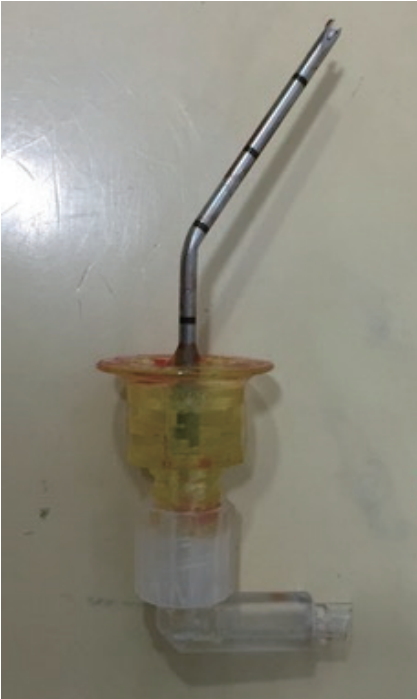Deformation of a humeral intraosseous catheter due to positioning for thoracostomy
Article information
An adult victim of a motor vehicle collision was treated by a helicopter emergency medical service team. Major head and thoracic injuries were managed by on scene rapid sequence intubation and open thoracostomy. A 45-mm 15-gauge humeral intraosseous needle (EZ-IO; Vidacare Corporation, Shavano Park, TX, USA) was used for vascular access prior to other procedural interventions. The intraosseous catheter was removed in the emergency department using the standard manufacturer recommended technique by trauma team staff following establishment of further definitive venous access. There were no difficulties in removing it and it appeared to have been functioning effectively.
Following removal the intraosseous catheter was noted to be deformed (Fig. 1). A chest radiograph taken prior to removal showed the correct insertion point in the proximal humerus with no evidence of local bony injury, but with a bend in the catheter located at the insertion site.
Intraosseous access is increasingly utilized as the initial and sometimes sole source of resuscitative vascular access. The proximal humerus is preferred by some providers over the proximal tibia site as flow rates are favourable [1] and there is unimpeded access to the device in a patient restrained in an ambulance or helicopter. One disadvantage of humeral access is the risk of dislodgement of the catheter on elevating or abducting the arm, which has been described both during patient transfer and positioning for computed tomography scanning [2]. Abutment of the needle against the acromion is one proposed mechanism for this [3].
In order to access the lateral chest for thoracostomy our clinicians usually abduct and externally rotate the humerus, and we have previously observed that this can cause dislodgement of proximal humeral intraosseous catheters [4]. This is our first recorded case of a deformed catheter, which is very likely a result of arm positioning for thoracostomy. Clinicians should be aware of the risk of both dislodgement and deformation of proximal humeral intraosseous catheters during abduction and external rotation of the humerus.
Notes
No potential conflict of interest relevant to this article was reported.
References
Article information Continued
Notes
Capsule Summary
What is already known
Proximal humeral intraosseous access can be used in trauma prior to establishment of venous access. Dislodgement of these lines has been previously described secondary to shoulder abduction.
What is new in the current study
Deformation of a humeral intraosseous needle occurred in a trauma patient who had undergone ipsilateral thoracostomy. This is likely due to shoulder abduction and external rotation. Clinicians should be careful when positioning trauma patients with humeral intraosseous needles due to the risk of both dislodgement and deformation.
